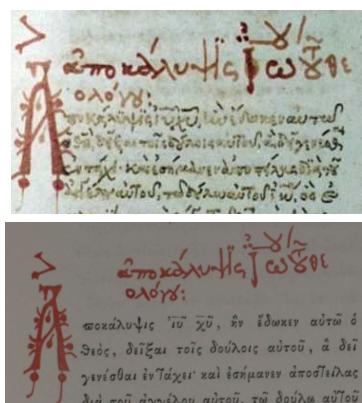A comment arrives from Joel Richardson, author of Antichrist: Islam’s Awaited Messiah (endorsed by Robert Spencer) and co-author of WorldNetDaily‘s new book Why We Left Islam: Former Muslims Speak Out (which I blogged here). Richardson is unhappy with my debunking of his associate Walid Shoebat’s claim that Greek number “666” in the Book of Revelation is actually the author’s attempt to write “In the name of Allah” in Arabic.
Shoebat claims that he realised this after consulting ancient codices, in particular the Codex Vaticanus. One point I made was that Codex Vaticanus does not contain the Book of Revelation (although it wasn’t my main point, and I did allow that Shoebat may perhaps have seen some other ancient manuscript, such as one that is doing the rounds online). Richardson blows his raspberry:
I went to the personal blog of the author of this article and saw that the image that he has posted of himself shows him sitting in a pub sipping a pint of beer. I fear that he may have been sipping a bit too much before writing this article.
The Codex Vaticanus does indeed contain the Book or Revelation, it is simply a later supplementation to the earlier manuscripts. A tiny bit of research could have produced this fact. The actual image of the portion of the Book of revelation that is part of the Codex Vaticanus is below. Scroll to the third column to the right and the top line, marked 18 (Revelation 13:18) contains the image that Walid used:
www.csntm.org/Manuscripts/GA%2003/GA03_150b.jpg
Images of the entire Codex may be viewed here:
www.csntm.org/Manuscripts/GA%2003/
Which could have been found if Mr. Bartholomew had gone here instead of sipping beer:
www.csntm.org/Manuscripts.aspx
Next time, you may wish to step outside of the usual Wikipedia sourcing for your articles Richard.
Actually, I researched this using various sources, such as The HarperCollins Encyclopedia of Catholicism (1995):
Codex Vaticanus, a fourth century manuscript of the Greek Bible…All NT Scripture after Heb 9:14 is missing.
Other scholarly sources concur (Google Books is useful here). The older Catholic Encyclopedia gives some further background:
In modern times (fifteenth-sixteenth century) the missing folios were added to the codex, in order, as Tregelles conjectures, to prepare it for use in the Vatican Library.
Presumably this is the origin of the “later supplementation” that Richardson thinks in some way makes Shoebat’s case stronger; a supplement added 1,000 years later in Italy that in no way can be seen as part of the original codex. But there’s worse: the jpeg in fact shows a page from the 1868 Bibliorum Sacrorum Graecus Codex Vaticanus. This is a facsimile of the ancient text, but with a clearly typeset version of Revelation tacked on at the end. Here’s how the start of Revelation appears in the fifteenth-century manuscript compared with how it appears in the 1868 edition:
Incidentally, this “minuscule” way of writing Greek developed in the Seventh Century, and there are no examples prior to 835; the ancient Codex Vaticanus was written in an “uncial” form that looks more like block capitals (see Bruce Metzger, Manuscripts of the Greek Bible: An Introduction to Greek Palaeography, Oxford University Press 1991, and also this website).
So, Richardson is telling us that Shoebat used a nineteenth-century typeset edition of Revelation to draw the paleographic conclusion that a fourth-century Greek manuscript of the book (which doesn’t exist anyway) meant to show Arabic letters!
Let’s make this as simple as possible: if you read Revelation 13, it is obvious that the phrase for “666” appears where you would expect to see a number. The wider religious context here is numerology, which Shoebat rejects simply because he finds numerology objectionable. Early Christian tradition and manuscript evidence from long before Codex Vaticanus was written also both point to a number, either “666” or “616”. A fifteenth-century “supplementation” in a different script has no evidential value whatsoever, let alone a nineteenth-century typeset version!
Perhaps Richardson could do with a drink…
Filed under: Uncategorized | 42 Comments »



